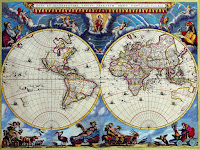 What do you know about your
ancestors? You may have documented births, marriages and deaths, but do you
know who they were? Where they lived? Where they came from? What were the economics and
demographics of their time and place?
What do you know about your
ancestors? You may have documented births, marriages and deaths, but do you
know who they were? Where they lived? Where they came from? What were the economics and
demographics of their time and place?
These are questions that
often could not be easily answered in years gone by. Today’s technology helps
us find those answers.
In James Tanner’s recent blog post Where is Genealogy Technologically-wise?, he begins by discussing the history of
genealogy and the limitations imposed by the technology of the times. Early
researchers often were lucky if they could find names and dates. But the
evolution of technology is giving us access to unprecedented amounts of
information.
What excites
me and inspired this post was having such a revered genealogist remind us all
that our ancestors were real people about whom we can learn more than just names
and dates. He encourages us to take full advantage of technology. With his
permission, I present the second part of that post. (See the link above to read
the entire post.)
Genealogy involves several skills
that draw on several areas of academic expertise. If you look at the common
divisions of academia as reflected in university catalogs, you would see that
genealogy involves many different areas. These include some of the following
disciplines:
·
History
·
Languages
·
Library Science
·
Geography
·
Economics
If we break away from thinking of genealogy as a trivial hobby of filling out forms, we begin to see the limitations of constraining our records to electronic representations of paper forms. Rather than "attaching a source or memory" about a person, what if we begin with a narrative? Rather than being presented by a program with a series of blank fields, what if we were guided by a series of questions about the person's life? Let's suppose the computer program started out like this:
What do you know about your father (mother, aunt, uncle, etc.)? Where was your (relative) born? Who were the members of his or her family? Do you have any photos or stories you can remember about this relative? We have found a U.S. Census record that seems to have information about your (ancestor). What do you see in this record that might help add information about this person or family? Here is a timeline of the time when your ancestor lived? Do you know where the ancestor lived?
In other words, we break out of the shackles of the paper-based view of genealogy and start putting the information into a historical context and do this by begging (sic) a narrative. What do we end up with? Essentially a website dedicated to a family with links and photos and stories.
At the same time, we could add in some artificial intelligence that could begin to correct the information entered. For example, an extensive expansion of the error messages now generated by some programs.
The interesting thing is that all this is now available. Rather than providing a confusing pile of information, how about using the computers to organize, help evaluate and record the information in a way that leads us through the process rather than requiring years of experience to get started?

No comments:
Post a Comment